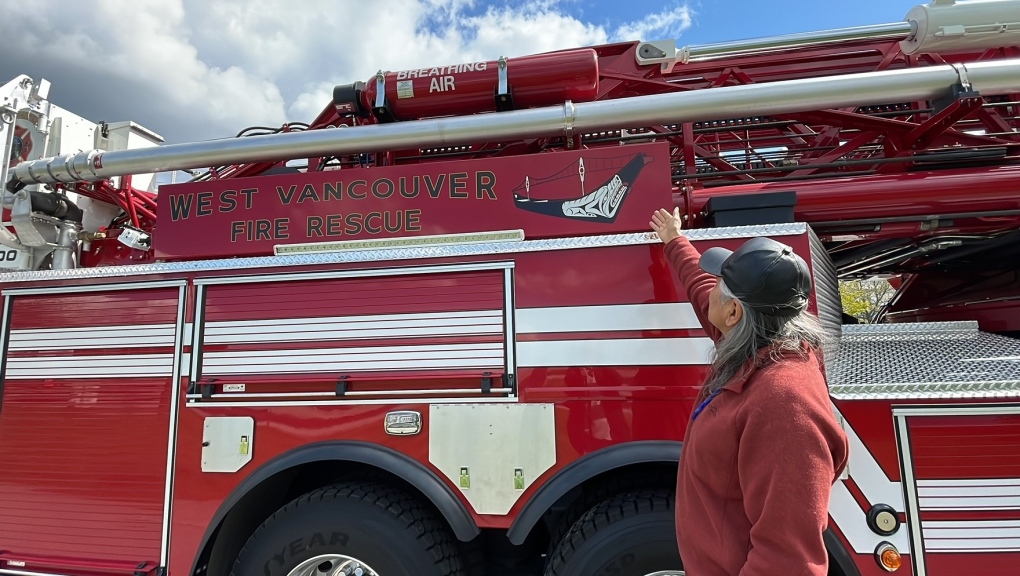'A step to move us forward': West Vancouver firetruck with Squamish art hits the streets
 Sḵwx̱wú7mesh Úxwumixw artist Xwalacktun explains the symbolism behind the art he designed for a new firetruck in West Vancouver
Sḵwx̱wú7mesh Úxwumixw artist Xwalacktun explains the symbolism behind the art he designed for a new firetruck in West Vancouver
A new firetruck in West Vancouver features the work of an artist from the Sḵwx̱wú7mesh Úxwumixw (Squamish Nation), a move everyone involved hopes will be a step toward reconciliation.
Asst. Chief Jeremy Calder says the department was due to purchase a new tower truck, to replace an older one with something safer and more environmentally friendly.
But two years ago the department asked whether replacing this critical piece of equipment might be an opportunity to do something more.
"Wouldn't it be cool if we could get Indigenous artwork on our new fire tower truck to promote reconciliation and recognize our Indigenous communities?" Calder says, recalling the question his chief raised at the time.
The design was created by Xwalacktun, an internationally-renowned artist whose work can be seen across the North Shore and beyond, including pieces commissioned by the West Vancouver Police Department and school board.
He says having his work on the truck, where it can be seen widely and serve the community on his Nation's traditional territory is one reason he was eager to collaborate with the department.
"I see this as a powerful act in Truth and Reconciliation. Many elders and chiefs have said that ‘we are invisible on our own land’ and having Indigenous artwork visible on a service vehicle will bring pride to them and the community,” he said in a statement, adding that words from Louis Riel emphasize the power of art to provoke change.
“A quote that always stuck with me is, ‘My people will sleep for one hundred years, but when they awake, it will be the artists who give them their spirit back.’"

The completed artwork includes Thunderbird and Longhouse on the large roll-up door on the rear of the truck. Xwalacktun tells CTV News that these elemnts represent protection, family, and strength
On the side of the truck is a West Coast canoe, with paddles up, holding the Lions Gate Bridge.
We're all in a canoe together, we're pulling together. We've got to maintain balance, and we're also family," he says of this part of the design.
"The bridge is to symbolize we've got to bring our cultures together, and bridge our thoughts together, and work together as one."
The truck is now operating in the community, following a private gathering that included a Squamish ceremony, and fire department rituals.
Kids from the community – including Xwalacktun's son -- also attended, danced, and drummed. Calder says the intergenerational nature of the gathering made it particularly powerful.
"It's possible that one day they may be driving this fire truck or be an officer on this fire truck. So it's really exciting," he said.

Calder says the truck, which allows crews to climb higher than before, now also lifts up the community as a whole. Beyond that, it promotes an important dialogue.
"It's a billboard in the community that's going to be there for the next 20 years, speaking to our commitment towards reconciliation and sparking conversation. It's one small step that just builds the momentum," he says.
"It's just sparked so many conversations and new opportunities."
Xwalacktun says he feels the same way.
"We're moving in a good direction with Truth and Reconciliation. We create community by taking a risk and just asking questions. Let's move forward. It's not going to happen today or tomorrow, but it's a step to move us forward to where we need to be."
With files from CTV News Vancouver's Shelley Moore
CTVNews.ca Top Stories

Prime Minister Trudeau meets Donald Trump at Mar-a-Lago
Prime Minister Justin Trudeau landed in West Palm Beach, Fla., on Friday evening to meet with U.S.-president elect Donald Trump at Mar-a-Lago, sources confirm to CTV News.
'Mayday! Mayday! Mayday!': Details emerge in Boeing 737 incident at Montreal airport
New details suggest that there were communication issues between the pilots of a charter flight and the control tower at Montreal's Mirabel airport when a Boeing 737 made an emergency landing on Wednesday.
Hit man offered $100,000 to kill Montreal crime reporter covering his trial
Political leaders and press freedom groups on Friday were left shell-shocked after Montreal news outlet La Presse revealed that a hit man had offered $100,000 to have one of its crime reporters assassinated.
Questrade lays off undisclosed number of employees
Questrade Financial Group Inc. says it has laid off an undisclosed number of employees to better fit its business strategy.
Cucumbers sold in Ontario, other provinces recalled over possible salmonella contamination
A U.S. company is recalling cucumbers sold in Ontario and other Canadian provinces due to possible salmonella contamination.
Billboard apologizes to Taylor Swift for video snafu
Billboard put together a video of some of Swift's achievements and used a clip from Kanye West's music video for the song 'Famous.'
Musk joins Trump and family for Thanksgiving at Mar-a-Lago
Elon Musk had a seat at the family table for Thanksgiving dinner at Mar-a-Lago, joining President-elect Donald Trump, Melania Trump and their 18-year-old son.
John Herdman resigns as head coach of Toronto FC
John Herdman, embroiled in the drone-spying scandal that has dogged Canada Soccer, has resigned as coach of Toronto FC.
Weekend weather: Parts of Canada could see up to 50 centimetres of snow, wind chills of -40
Winter is less than a month away, but parts of Canada are already projected to see winter-like weather.

































